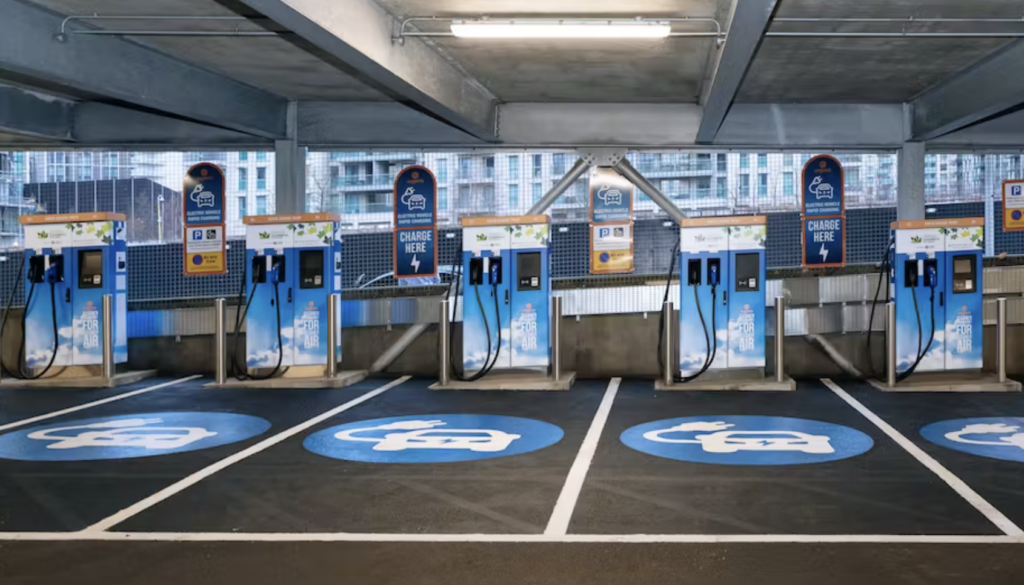The English capital offers an interesting case study as it scrambles to support a growing number of electric vehicles. By Drew Meehan
London Mayor Sadiq Khan has been steadfast in his ambition for the UK’s capital to be a net zero-carbon city by 2030. Underpinning this target is a need for London to lead the charge on electric vehicle (EV) adoption. In many respects, the city is well on the way to becoming an EV hub, with plans in motion to expand the London Ultra Low Emission Zone (ULEZ). Additionally, electric buses are being scaled up in key boroughs and Uber has significantly increased its share of electric taxis in operation across the city.
Even so, travelling in urban environments like London remains synonymous with delays, traffic congestion, and pollution. According to the latest TomTom data, London remained the worst city in the UK for travel-related emissions in 2022. Overall, travel-related emissions in the centre of London increased by 2% between 2021 to 2022, despite the first ULEZ expansion starting in October 2021.

TomTom data shows that increasing London’s EV ratio by just 1% would write off 155,000 tonnes of CO2 emissions. Recent policy and corporate initiatives to boost the city’s EV ratio has positioned London as a world leader in the shift to more sustainable transport, according to the International Council on Clean Transportation. As the race for global EV leadership rages on, can London maintain its leading position and encourage further adoption?
Alleviating range and charging anxiety
The reality is the transition to electric-powered vehicles remains a decision tinged with anxiety for both businesses and citizens, which is most often linked to uncertainty around fast-charging infrastructure and vehicle range. The challenge is to convince the capital’s drivers to trust the technology enough by removing the two major psychological barriers hampering large-scale adoption: range and charging anxiety.
With 74% of EV owners disappointed with the UK’s current infrastructure (according to Which?), more needs to be done to tackle charging point reliability and subsequent charging anxiety. Those in charge of London policy should focus on the 8,600 new public charging points that have already been installed across London, making up a third of the UK’s total charging points. Further education should also be provided around plans to introduce around 40,000 to 60,000 more charging points by 2030, as part of Transport for London’s EV infrastructure strategy.
Additionally, EV manufacturers and solution providers have a responsibility to educate end-users on the technologies that exist today to minimise such challenges. For example, innovative mapping technologies can connect directly to EV sensors and batteries to help drivers plan more efficient routes, providing real-time recommendations on where and when to charge. Charge point operators should also take more responsibility for the maintenance of EV charging stations and providing reliable data to consumers rather than solely focusing on increasing installation if there’s any hope of addressing charging anxiety in the UK.

There are mapping technologies that can accurately predict range and offer charging suggestions by measuring battery capacity and state of charge alongside location data and real-time traffic information. These technologies combine data about EV charging station location and reliability, as well as map data such as slope, curvature, historic speed profiles, traffic jams to offer routes that drivers can trust, as well as reliable estimated times of arrival. With a clear view of the road ahead, both individual drivers and those operating EV fleets can feel confident that they will reach their destination in the most cost-effective and energy-efficient way possible.
Managing the capital’s traffic flow
In addition to the EV transition, more effective traffic control will be needed to reach London’s goal of net zero carbon emissions by 2030. While more than four in five vehicles already meet current emissions standards, the sheer volume of traffic across the capital continues to have a significant impact on transport emissions. The ongoing train strikes heavily affected levels of congestion, with commuters opting to use vehicles to get around cities in the absence of train services. A lack of black cab drivers may also have prompted more drivers into the city. It’s inevitable that vehicles become stuck in slow-moving and heavily-polluting traffic when an increased number of drivers is combined with the capital’s antiquated road infrastructure.
The sheer volume of traffic across the capital continues to have a significant impact on transport emissions
Looking ahead, city planners will need to consider how location and mapping technologies can help to redesign London’s transport infrastructure and support multi-modal travel. A potential use case includes harnessing in-road sensors to identify and monitor traffic flow, enabling the change of traffic light sequences in real-time to keep traffic moving. Additionally, traffic flow and the allocation of public space will need to be adjusted to account for increased public transport and EV infrastructure. For best results, location and mapping technologies should be underpinned by real-time traffic flow data from a range of private and open-source datasets.
As London continues to set the standard for EV ambitions, the capital’s city planners, EV manufacturers and technologists must come together to ensure that every aspect of the user journey is hassle-free. With uncertainty around the capital’s charging capacity remaining a core barrier to adoption, it is up to the transport community to work together to harness and promote the use of next-generation location and mapping technologies to propel London towards its net zero emissions goal.
About the author: Drew Meehan is Senior Product Manager for Electric Vehicles at TomTom
